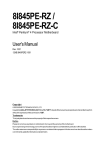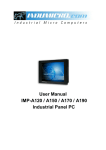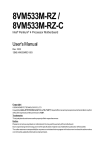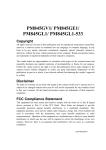Download GIGABYTE GA-8ILFT User's Manual
Transcript
GA-8ILFT Series
P4 Titan-DDR Motherboard
USER’S MANUAL
Pentium® 4 Processor Motherboard
Rev. 1001
12ME-8ILFT-1001
English
Table of Content
Item Checklist ..................................................................................4
WARNING! .......................................................................................4
Chapter 1 Introduction .......................................................................5
Features Summary ................................................................................................ 5
GA-8ILFT Series Motherboard Layout .............................................................. 7
Chapter 2 Hardware Installation Process ............................................8
Step 1: Install the Central Processing Unit (CPU) ........................................... 9
Step1-1 CPU Installation ................................................................................ 9
Step1-2 CPU Heat Sink Installation ................................................................ 10
Step 2: Install memory modules ....................................................................... 11
Step 3: Connect ribbon cables, cabinet wires, and power supply ............. 13
Step3-1 I/O Back Panel Introduction .............................................................. 13
Step3-2 Connectors Introduction ................................................................... 15
Chapter 3 BIOS Setup .................................................................... 22
The Main Menu (For example: BIOS Ver. :F1) .............................................. 23
Standard CMOS Features ................................................................................. 25
Advanced BIOS Features ................................................................................... 28
Integrated Peripherals ....................................................................................... 31
GA-8ILFT Series Motherboard
-2-
E
Power Management Setup ................................................................................ 35
PnP/PCI Configurations ...................................................................................... 37
PC Health Status .................................................................................................. 38
Frequency/Voltage Control ................................................................................ 40
Load Fail-Safe Defaults ...................................................................................... 42
Load Optimized Defaults .................................................................................... 43
Set Supervisor/User Password .......................................................................... 44
Save & Exit Setup ................................................................................................. 45
Exit Without Saving ............................................................................................. 46
Chapter 4 Technical Reference ........................................................ 47
Block Diagram ..................................................................................................... 47
Q-Flash Introduction ........................................................................................... 48
@ BIOS Introduction ........................................................................................... 50
Easy Tune 4TM Introduction ............................................................................... 51
Chapter 5 Appendix ....................................................................... 52
n
-3-
Table of Content
g
English
Item Checklist
þ
þ
þ
þ
The GA-8ILFT motherboard
IDE cable x 1/ Floppy cable x 1
CD for motherboard driver & utility (IUCD)
GA-8ILFT user’s manual
þ
I/O Shield
WARNING!
Computer motherboards and expansion cards contain very delicat e Integrated Circuit (IC) chips. To
protect them against damage from static electricity, you should follow some precautions whenever you
work on your computer.
1. Unplug your computer when working on the inside.
2. Use a grounded wrist strap before handling computer components. If you do not have
one, touch both of your hands to a safely grounded object or to a metal object, such as
the power supply case.
3. Hold components by the edges and try not touch the IC chips, leads or connectors, or
other components.
4. Place components on a grounded antistatic pad or on the bag that came with the
components whenever the components are separated from the system.
5. Ensure that the ATX power supply is switched off before you plug in or remove the ATX
power connector on the motherboard.
Installing the motherboard to the ch assis…
If the motherboard has mounting holes, but they don’t line up with the holes on the base and there are
no slots to attach the spacers, do not become alarmed you can still attach the spacers to the mounting
holes. Just cut the bottom portion of the spacers (the spacer may be a little hard to cut off, so be careful
of your hands). In this way you can still attach the motherboard to the base without worrying about short
circuits. Sometimes you may need to use the plastic springs to isolate the screw from the motherboard
PCB surface, because the circuit wire may be near by the hole. Be careful, don’t let the screw contact
any printed circuit write or parts on the PCB that are near the fixing hole, otherwise it may damage the
board or cause board malfunctioning.
GA-8ILFT Series Motherboard
-4-
E
Chapter 1 Introduction
Features Summary
—
—
CP U
—
20.3cm x 2.9cm Flex ATX size form factor, 4 layers PCB.
GA-8ILFT Series Motherboard:
GA-8ILFT and GA-8ILFT-C
Socket 478 for Intel® Micro FC-PGA2 Pentium® 4 processor
—
Support Intel® Pentium® 4 (Northwood, 0.13 m) processor
I/O Control
Slots
On-Board IDE
—
—
—
—
—
—
—
—
—
—
—
On-Board Peripherals
—
—
Intel Pentium® 4 400MHz FSB
2nd cache depends on CPU
Chipset 82845GL HOST/AGP/Controller
ICH4 I /O Controller Hub
2 184-pin DDR DIMM sockets
Supports P C1600 DDR or PC2100 DDR SDRAM
Supports up to 2GB DRAM (Max)
Supports only 2.5V DDR SDRAM
ITE8712
3 PCI slot supports 33MHz & PCI 2.2 compliant
An IDE controller on the Intel ICH4 PCI chipset
provides IDE HDD/CD-ROM with PIO, Bus Mast er (Ultra
DMA33/ATA66/ATA100) operation modes.
Can connect up to four IDE devices
1 Floppy port supports 2 FDD with 360K, 720K,1.2M, 1.44M
and 2.88M bytes.
1 Parallel port supports Normal/EPP/ECP mode
1 Serial ports (COMA), 1 VGA port
4 x USB 2.0/1.1 (2x Rear, 2Front by cable)
1 Front Audio connector
1 Serial IRQ connector
Built in Intel 845GL Chipset
AC97 CO DEC (RealTek A LC201A)
1 Buzzer
Line In/Line Out/Mic In/CD In/AUX In/Game Port/SPDIF
Chipset
Memory
On-Board VGA
On-Board Sound
—
—
—
—
—
—
—
—
—
n
Form Factor
Motherboard
to be continued......
-5-
Introduction
g
English
On-Board LAN*
Hardware Monitor
PS/2 Connector
BIOS
Additional Features
—
—
—
—
—
—
—
—
—
—
—
—
—
—
—
—
Builit in RTL8100BL Chipset
1 RJ45 port
CPU/System Fan Revolution detect
CPU/System Fan Control
CPU O verheat Warning
System Voltage Detect
PS/2 Keyboard interface and PS/2 Mouse interace
Licensed AWARD B IOS, 2M bit FWH
External Modem wake up
PS/2 Keyboard password power on
PS/2 Mouse power on
AC Recovery
USB KB/ Mouse wake up from S3
Poly fuse for keyboard,USB,game port over-current protection
Supports @BIOS
Supports EasyTune4
Please set the CPU host frequency in accordance with your processor’s specifications.
We don’t recommend you to set the system bus frequency over the CPU’s specification
because these specific bus frequencies are not the standard specifications for CPU,
chipset and most of the peripherals. Whether your system can run under these specific
bus frequencies properly will depend on your hardware configurations, including CPU,
Chipsets,SDRA M,Cards….etc.
* For GA-8ILFT Only.
GA-8ILFT Series Motherboard
-6-
CPU_FAN
COMA
ATX_12V
LPT
VGA
ATX_POWER
KB_MS
FDD
DDR2
DDR1
E
GA-8ILFT Series Motherboard Layout
IDE1
IDE2
F_AUDIO
Intel 845GL
GAME
MIC_IN LINE_OUT
LINE_IN
SOCKET478
GA-8ILFT
BAT1
RTL8100BL*
CI
S_IRG
CD_IN
PCI1
F_USB1
AUX_IN
PCI3
BIOS
F_PANEL
PCI2
BIOS_WP
AC97
Buzzer
ICH4
CLR_COMS
ITE8712
SYS _FAN
USB/
LAN*
SPDIF
n
* For GA-8ILFT Only.
-7-
Introduction
g
English
Chapter 2 Hardware Installation Process
To set up your computer, you must complete the following steps:
Step 1- Install the Central Processing Unit (CPU)
Step 2- Install memory modules
Step 3- Connect ribbon cables, cabinet wires, and power supply
Step 4- Setup BIOS software
Step 5- Install supporting software tools
Step1
Step4
Step 2
Step 4
Step 4
Step3
GA-8ILFT Series Motherboard
-8-
E
Step 1: Install the Central Processing Unit (CPU)
Step 1-1 : CPU Installation
Pin1 indicator
Pin1 indicator
CPU Top V iew
CPU Bott om View
Socket Actuation Lever
1. Pull up the CP U socket lever
and up to 90-degree angle.
3. Press down the CPU socket
lever and finish CPU installation.
Pin1 indicator
2. Locate Pin 1 in the socket and look
for a (golden) cut edge on the CPU
upper corner. Then insert the CPU
into the socket.
M Please make sure the CPU type is supported by the motherboard.
M If you do not match the CPU socket Pin 1 and CPU cut edge well, it will cause
-9-
n
improper installation. Please change the insert orientation.
Hardware Installation Process
g
English
Step 1-2 : CPU Heat Sink Installation
2. Hook the other end of the
cooler bracket to the CPU
socket.
1. Hook one end of the cooler
bracket to the CPU socket first.
M Please use Intel ap proved cooling fan.
M We recommend you to apply the thermal tape to provide better heat
conduction between your CPU and heatsink.
(The CPU cooling fan might stick to the CPU due to the hardening of the
thermal paste. During this condition if you try to remove the cooling fan, you
might pull the processor out of the CPU socket alone with the cooling fan, and
might damage the processor. To avoid this from happening, we suggest you to
either use thermal tape instead of thermal paste, or remove the cooling fan with
extreme caution.)
M Make sure the CPU fan power cable is plugged in to the CPU fan connector,
this completes the installation.
M Please refer to CPU heat sink user’s manual for more detail installation
procedure.
GA-8ILFT Series Motherboard
- 10 -
E
Step 2: Install memory modules
The motherboard has 2 dual inline memory module (DIMM) sockets. The BIOS will automatically
detects memory type and size. To install the memory module, just push it vertically into the DIMM Slot
.The DIMM module can only fit in one direct ion due to the notch. Memory size can vary bet ween
sockets.
Total Memory Sizes With Unbuffered DDR DIMM
Devices used on DIMM
1 DIMM x 64 / x 72
2 DIMMs x 64 / x 72
64 Mbit (2M x8x4 banks)
64 Mbit (1M x16x4 banks)
128 Mbit(4M x8x4 banks)
128 Mbit(2M x16x4 banks)
256 Mbit(8M x8x4 banks)
256 Mbit(4M x16x4 banks)
512 Mbit(16Mx8x4 banks)
512 Mbit(8M x16x4 banks)
128 MBytes
32 MBytes
256 MBytes
64 MBytes
512 MBytes
128 MBytes
1 GBytes
256 MBytes
256 MBytes
64 MBytes
512 MBytes
128 MBytes
1 GBytes
256 MBytes
2 GBytes
512 MBytes
Notes: Double-sided x16 DDR memory devices are not support by Intel 845 chipset.
DDR
1. The DIMM slot has a notch, so the
DIMMmemory module can only fit in one direction.
2. Insert the DIMM memory module verticallyinto the
DIMM slot. Then push it down.
3. Close the plastic clip at both edges of theDIMM slots
to lock the DIMM module.
Reverse the installation steps when you wish to
remove the DIMM module.
n
M When STR/DIMM LED is ON, you do not install / remove DDR from socket.
- 11 -
Hardware Installation Process
g
English
DDR Introduction
Established on the existing SDRAM industry infrastructure, DDR (Double Data Rate) memory is a
high performance and cost-effective solution that allows easy adoption for memory vendors, OEMs and
system integrators.
DDR memory is a sensible evolutionary solution for the PC industry t hat builds on the existing
SDRAM infrastructure, yet makes awesome advances in solving the system performance bottleneck by
doubling t he memory bandwidth. DDR SDRAM will of fer a superior solution and migration path from
existing S DRAM designs due to its availability, pricing and overall market support. PC2100 DDR
memory (DDR266) doubles the data rate through reading and writing at both the rising and falling edge of
the clock, achieving data bandwidth 2X greater than PC133 when running with the same DRAM clock
frequency. With peak bandwidth of 2.1GB per second, DDR memory enables system OEMs to build
high performance and low latency DRAM subsystems that are suitable for servers, workstations, highend PC's and value deskt op S MA systems. With a core voltage of only 2. 5 Volts compared to
conventional SDRAM's 3.3 volts, DDR memory is a compelling solution for small form factor desktops
and notebook applications.
GA-8ILFT Series Motherboard
- 12 -
E
Step 3: Connect ribbon cables, cabinet wires, and power
supply
Step3-1 : I/O Back Panel Introduction
v
u
w
y*
x
u PS/2 Keyboard and PS/2 Mouse Connector
PS/2 Mouse Connector
(6 pin Female)
ØThis connector supports standard PS/2
keyboard and PS/2 mouse.
PS/2 Keyboard Connector
(6 pin Female)
v Parallel Port and Serial Ports (COM1/COM2)
Parallel Port
(25 pin Female)
ØThis connector supports 2 standard COM ports
and 1 Parallel port. Device like printer can be
connected to Parallel port ; mouse and modem
etc can be connected to Serial ports.
COMA
VGA Port
(15 pin Female)
n
Serial Port
(9 pin Male)
VGA
- 13 -
Hardware Installation Process
g
English
w Game /MIDI Ports
ØThis connector supports joystick, MIDI keyboard and other
relate audio devices.
Joystick/ MIDI (15 pin Female)
x Audio Connectors
Ø After install onboard audio driver, you may connect
speaker to Line Out jack, micro phone to MIC In jack.
Device like CD-ROM , walkman etc can be connected
to Line-In jack.
Line Out
MIC In
Line In
y USB/LAN* Connector
LA N*
Connector
USB 0
USB 1
ØBefore you connect your device(s) into USB connector(s),
please make sure your device(s) such as USB keyboard,
mouse, scanner, zip,speaker..etc. Have a standard USB
interface. Also make sure your OS (Win 95 with USB
supplement, Win98, Windows 2000, Windows ME, Win
NT with SP 6) supports USB controller. If your OS does not
support USB controller, please contact OS vendor for possible patch or driver upgrade. For more information please
contact your OS or device(s) vendors.
* For GA-8ILFT Only.
GA-8ILFT Series Motherboard
- 14 -
A
E
Step 3-2 : Connectors Introduction
B
C
D
E
Q
P
O
F
G
N
H
I
M
L
K
J
A) ATX_12V
J) BIOS_WP
B) CPU_FAN
K) F_U SB1
C) ATX
L) BATTERY
D) FDD
M) AUX_IN
E) IDE1/ID E2
N) CD_IN
F) SYS_FAN
O) S_IR Q
G) C I
P) SPDIF
H) CLR_CMOS
Q) F_AUDIO
I) F_PANEL
n
* For GA-8ILFT Only.
- 15 -
Hardware Installation Process
g
3 4
+12V
GND
+12V
GND
ØThis connector (ATX +12V) suppliesthe CPU
operation voltage (Vcore).
If this " ATX+ 12V connector" is not connected,
system cannot boot.
1 2
B) CPU_FAN (CPU FAN Connector)
Ø Please note, a proper installation of the CPU
cooler is essential to prevent the CPU from
running under abnormal condition or damaged
by overheating.The CPU fan connector
Sense
+12V/Control
GND
English
A) ATX_12V ( +12V Power Connector)
supports Max. current up to 600 mA.
1
F) SYS_FAN (System FAN Connector)
Sense
+12V/Control
GND
1
Ø This 2 pin connector allows your system to
enable or disable the system alarm if the sys
tem case begin remove.
G) CI (CA SE OPEN)
1
GND
Signal
GA-8ILFT Series Motherboard
- 16 -
E
D) FDD (Floppy Connector)
1
E) IDE1/ IDE2 (IDE1/IDE2 Conn ector)
1
IDE2
IDE1
1
Ø Important Notice:
Please connect first harddisk to IDE1
and connect CDROM to IDE2.
USB Over
Current
Power
USB DyUSB Dy+
GND
K) F_USB 1 (Front USB Co nnector)
Ø Be careful with the polarity of the front
panel USB connector. Check the pin
assignment while you connect the front
panel USB cable. Please contact your
nearest dealer for optional front panel
USB cable.
Power
USB DxUSB Dx+
GND
n
1
- 17 -
Hardware Installation Process
g
English
N) CD_IN (CD IN)
1
CD-L
GND
CD-R
CD_I N
Q)F_AUDIO (F_AUDIO Connector)
MI C
REF
Front Audio (R)
Reserved
Front Audio (L)
Ø If you want to use Front Audio connector, you
must remove 5-6, 9-10 Jumper.
In order to utilize the front audio header, your chassis must have front audio connector. Also please
make sure the pin assigment on the cable is the
GND
POWER
same as the pin assigment on the MB header. To
Rear Audio (R)
find out if the chassis you are buying support front
Rear Audio (L) audio connector, please contact your dealer.
1
P) SPDIF (SPD IF)
1
V CC
SPDIF OUT
GND
GA-8ILFT Series Motherboard
Ø The SPDIF output is capable of providing digital
audio to external speakers or compressed AC3
data to an external Dolby Digital Decoder. Use
this feature only when your stereo system has
digital output function.
- 18 -
1
3.3V
-12V
GND
PS-ON(SoftOn/Off)
GND
GND
GND
-5V
V CC
V CC
20
ØAC power cord should only be connected to
E
C) ATX_POWER (ATX Power)
your power supply unit after ATX power cable
and other related devices are firmly
3.3V
3.3V
connected to the mainboard.
GND
V CC
GND
V CC
GND
Power Good
5V SB (Stand by +5V)
+12V
J) B IOS_WP (BIOS Write Protect ion)
Ø Please note, To flash/upgrade BIOS on this MB
BIOS_WP must be set to 2-3 close. We
recommend BIOS_WP to be set to "1-2 close",
2-3 close: Normal
1
whenever user does not need to flash/upgrade
the BIOS.
1-2 close: Write Protection
1
Signal
GND
O) S_IRQ (For special design, for example: PCMCIA add on card)
n
1
- 19 -
Hardware Installation Process
g
1
AUX-L
GND
AUX-R
English
M) AUX_IN ( AUX In Connector)
H) CLR _CMOS (Clear CMOS)
Ø You may clear the CMOS data to its default
values by this jumper.
2-3 close: Normal
1
1-2 close: Clear CMOS
1
L) BATTERY (Battery)
+
GA-8ILFT Series Motherboard
CAUTION
v Danger of explosion if battery is incorrectly
replaced.
v Replace only with the same or equivalent
type recommended by the manufacturer.
v Dispose of used batteries according to the
manufacturer’s instructions.
- 20 -
13
14
E
I) F_PANEL (2x7 pins connector)
RSTRST+
SPK+ 1
PW+
PWPD+
PD_GPD_Y-
SPK2
HD (IDE Hard Disk Active LED)
SPK (Speaker Connector)
RST (Reset Switch)
PD+/PD_G-/PD_Y-(Power LED)
PW (Soft Power Connector)
1
1 HD+
HD-
Pin 1: LED anode(+)
Pin 2: LED cathode(-)
Pin 1: VCC(+)
Pin 2- P in 3: NC
Pin 4: Data(-)
Open: Normal Operation
Close: Reset Hardware System
Pin 1: LED anode(+)
Pin 2: LED cathode(-)
Pin 3: LED cathode(-)
Open: Normal Operation
Close: Power On/Off
Ø Please connect the power LED, PC speaker, reset switch and power switch etc of your chassis
front panel to the F_PANEL connector according to the pin assignment above.
n
- 21 -
Hardware Installation Process
g
English
Chapter 3 BIOS Setup
BIOS Setup is an overview of the BIOS Setup Program. The program that allows users to modify the
basic system configuration. This type of information is stored in battery-backed CMOS RAM so that it
retains the Setup information when the power is turned off.
ENTERING SETUP
Powering ON the computer and pressing <Del> immediately will allow you to enter Setup. If you require
more advanced BIOS settings, please go to “Advanced BIOS” setting menu.To enter Advanced BIOS
setting menu, press “Ctrl+F1” key on the BIOS screen.
CONTROL KEYS
<á>
Move to previous item
<â>
Move to next item
<ß>
Move to the item in the left hand
<à>
Move to the item in the right hand
<Esc>
Main Menu - Quit and not save changes into CMOS Status Page Setup Menu and
Option Page Setup Menu - Exit current page and return to Main Menu
<+/P gUp> Increase the numeric value or make changes
<-/PgDn>
Decrease the numeric value or make changes
<F1>
General help, only for Status Page Setup Menu and Option Page Setup Menu
<F2>
Reserved
<F3>
Reserved
<F4>
Reserved
<F5>
Restore the previous CMOS value from CMOS, only for Opt ion Page Setup Menu
<F6>
Load the file-safe default CMOS value from BIOS default table
<F7>
Load the Optimized Defaults
<F8>
Q-Flash function
<F9>
Reserved
<F10>
Save all the CMOS changes, only for Main Menu
GA-8ILFT Series Motherboard
- 22 -
E
GETTING HELP
Main Menu
The on-line description of the highlighted setup function is displayed at the bottom of the screen.
Status Page Setup Menu / Option Page Setup Menu
Press F1 to pop up a small help window that describes the appropriate keys to use and the possible
selections for the highlighted item. To exit the Help Window press <Esc>.
The Main Menu (For example: BIOS Ver. : F1)
Once you enter Award BIOS CMOS Setup Utility, the Main Menu (Figure 1) will appear on the screen.
The Main Menu allows you to select from eight setup functions and two exit choices. Use arrow keys to
select among the items and press <Enter> to accept or enter the sub-menu.
CMOS Setup Utility-Copyright (C) 1984-2002 Award Software
}Standard CMOS Features
Top Performance
}Advanced BIOS Features
Load Fail-Safe Defaults
}Integrated Peripherals
Load Optimized Defaults
}Power Management Setup
Set Supervis or Password
}PnP/PCI Configurations
Set User Password
}PC Health Status
Save & Exit Setup
}Frequency/Voltage Control
Exit Without Saving
ESC:Quit
higf:Select Item
F8: Q-Flash
F10:Save & Exit Setup
Time, Date, Hard Disk Type...
Figure 1: Main Menu
l
Standard CMOS Features
This setup page includes all the items in standard compatible BIOS.
Advanced BIOS Features
n
l
This setup page includes all the items of Award special enhanced features.
- 23 -
BIOS Setup
g
English
l
IntegratedPeripherals
This setup page includes all onboard peripherals.
l
PowerManagement Setup
This setup page includes all the items of Green function features.
l
PnP/PCI Configurations
This setup page includes all the configurations of PCI & PnP ISA resources.
l
PC Health Status
This setup page is the System auto detect Temperature, voltage, fan, speed.
l
Frequency/Voltage Control
This setup page is control CPU’s clock and frequency ratio.
l
TopPerformance
If you wish to maximize the performance of your system, set "Top Performance" as "Enabled".
l
Select Language
This setup page is select multi language.
l
Load Fail-Safe Defaults
Fail-Safe Defaults indicates the value of the system parameters which the system would
be in safe configuration.
l
LoadOptimized Defaults
Optimized Defaults indicates the value of the system parameters which the system would
be in best performance configuration.
l
Set Supervisor password
Change, set, or disable password. It allows you to limit access to the system and Setup,
or just to Setup.
l
Set User password
Change, set, or disable password. It allows you to limit access to the system.
l
Save & Exit Setup
Save CMOS value settings to CMOS and exit setup.
l
ExitWithout Saving
Abandon all CMOS value changes and exit setup.
GA-8ILFT Series Motherboard
- 24 -
E
Standard CMOS Features
CMOS Setup Utility-Copyright (C) 1984-2002 Award Software
Standard CMOS Features
Date (mm:dd:yy)
Mon, Feb 21 2000
Item Help
Time (hh:mm:ss)
22:31:24
Menu Level u
Change the day, month,
}IDE Primary Master
None
}IDE Primary Slave
None
year
}IDE Secondary Master
None
<Week>
}IDE Secondary Slave
None
Sun. to Sat.
Drive A
1.44M, 3.5 in.
<Month>
Drive B
None
Jan. to Dec.
Floppy 3 Mode Support
Disabled
<Day>
Halt On
All, But Keyboard
1 to 31 (or maximum
Base M emory
640K
Extended Memory
130048K
<Year>
Total Memory
131072K
1999 to 2098
allowed in the month)
higf: Move Enter:Select +/-/PU/PD:Value F10:Save ESC:Exit
F5:Previous Values
F6:Fail-Safe Defaults
F1:General Help
F7:Optimized Defaults
Figure 2: Standard CMOS Features
C Date
The date format is <week>, <month>, <day>, <year>.
8Week
The month, Jan. Through Dec.
The day, from 1 to 31 (or the maximum allowed in the month)
The year, from 1999 through 2098
- 25 -
n
8Month
8Day
8Year
The week, from Sun to Sat, determined by the BIOS and is display only
BIOS Setup
g
English
C Time
The times format in <hour> <minute> <second>. The time is calculated base on the 24-hour militarytime clock. For example, 1 p.m. is 13:00:00.
C IDE Primary Master, Slave / IDE Secondary Master, Slave
The category identifies the types of hard disk from drive C to F that has been installed in the computer.
There are two types: auto type, and manual type. Manual type is user-definable; Auto type which will
automatically detect HDD type.
Note that the specifications of your drive must match with the drive table. The hard disk will not work
properly if you enter improper information for this category.
If you select User Type, related information will be asked to enter t o the following items. Enter the
information directly from the keyboard and press <Enter>. Such information should be provided in the
documentation form your hard disk vendor or the system manufacturer.
8CYLS.
Number of cylinders
8HEADS
Number of heads
8PRECOMP
Write precomp
8LANDZONE
Landing zone
8SECTORSNumber of sectors
If a hard dis k has not been installed select NONE and press <Enter>.
C Drive A / Drive B
The cat egory identifies the types of floppy disk drive A or drive B that has been installed in the
computer.
8None
No floppy drive installed
8360K, 5.25 in.
5.25 inch PC-type standard drive; 360K byte capacity.
81.2M, 5.25 in.
5.25 inch AT-type high-density drive; 1.2M byte capacity
(3.5 inch when 3 Mode is Enabled).
8720K, 3.5 in.
3.5 inch double-sided drive; 720K byte capacity
81.44M, 3.5 in.
3.5 inch double-sided drive; 1.44M byte capacity.
82.88M, 3.5 in.
3.5 inch double-sided drive; 2.88M byte capacity.
GA-8ILFT Series Motherboard
- 26 -
8Disabled
Normal Floppy Drive. (Default value)
8Drive A
Drive A is 3 mode Floppy Drive.
8Drive B
Drive B is 3 mode Floppy Drive.
8Both
Drive A & B are 3 m ode Floppy Drives.
E
C Floppy 3 Mode Support (for Japan Area)
C Halton
The category determines whether the computer will stop if an error is detected during power up.
8NO Errors
The system boot will not stop for any error that may be detected
and you will be prompted.
8All Errors
Whenever the BIOS detects a non-fatal error the system will be stopped.
8All, But Keyboard
The system boot will not stop for a keyboard error; it will stop for
8All, But Diskette
The system boot will not stop for a disk error; it will stop for all
all other errors. (Default value)
other errors.
8All, But Disk/Key
The system boot will not stop for a keyboard or disk error; it will
stop for all other errors.
C Memory
The category is display-only which is determined by POST (Power On Self Test) of the BIOS.
BaseMemory
The POST of the BIOS will determine the amount of base (or conventional) memory
installed in the system.
The value of the base memory is typically 512 K for systems with 512 K memory
installed on the motherboard, or 640 K for systems with 640 K or more memory
installed on the motherboard.
ExtendedMemory
The BIOS determines how much extended memory is present during the POST.
- 27 -
n
This is the amount of memory located above 1 MB in the CPU’s memory
address map.
BIOS Setup
g
English
Advanced BIOS Features
CMOS Setup Utility-Copyright (C) 1984-2002 Award Software
Advanced BIOS Features
First Boot Device
Floppy
Item Help
Second Boot Device
HDD-0
Menu Level u
Third Boot Device
CDROM
Boot Up Floppy Seek
Disabled
Init Display First
Onboard/AGP
Graphics Aperture Size
128MB
Graphics Share Memory
8MB
higf: Move Enter:Select +/-/PU/PD:Value F10:Save ESC:Exit
F5:Previous Values
F6:Fail-Safe Defaults
Figure 3: Advanced BIOS Features
C First / Second / Third Boot Device
8Floppy
Select your boot device priority by Floppy.
8LS120
Select your boot device priority by LS120.
8HDD-0~3
Select your boot device priority by HDD-0~3.
8SCSI
Select your boot device priority by SCSI.
8CDROM
Select your boot device priority by CDROM.
8ZIP
Select your boot device priority by ZIP.
8USB-FDD
Select your boot device priority by USB-FDD.
8USB-ZIP
Select your boot device priority by USB-ZIP.
8USB-CDROM Select your boot device priority by USB-CDROM.
8USB-HDD
Select your boot device priority by USB-HDD.
8LAN
Select your boot dev ice priority by LAN.
8Disabled
Select your boot device priority by Disabled.
GA-8ILFT Series Motherboard
- 28 -
F1:General Help
F7:Optimized Defaults
E
C Boot Up Floppy Seek
During POST, BIOS will determine the floppy disk drive installed is 40 or 80 tracks. 360 K type is
40 tracks 720 K, 1.2 M and 1.44 M are all 80 tracks.
8Enabled
BIOS searches for floppy disk drive to determine it is 40 or 80 tracks. Note
that BIOS can not tell from 720 K, 1.2 M or 1.44 M drive type as they are
all 80tracks.
8Disabled
BIOS will not search for the type of floppy disk drive by track number. Note
that there will not be any warning message if the drive installed is 360 K.
(Default value)
C Init Display First
8Onboard/AGP
Set Init Display First to onboard/AGP. (Default value)
8PCI
Set Init Display First to PCI.
C Graphics Aperture Size
8128MB
Set Graphics Aperture Size to 128MB. (Default value)
8Disabled
Disable this function.
C Graphics Share Memory
88MB
Set Graphics Share Memory to 8MB. (Default value)
81MB
Set Graphics Share Memory to 1MB.
n
- 29 -
BIOS Setup
g
English
Integrated Peripherals
CMOS Setup Utility-Copyright (C) 1984-2002 Award Software
Integrated Peripherals
On-Chip Prim ary PCI IDE
Enabled
Item Help
On-Chip Secondary PCI IDE
Enabled
Menu Level u
IDE1 Conductor Cable
Auto
If a hard disk
IDE2 Conductor Cable
Auto
controller card is
USB Controller
Enabled
used, set at Disable
USB Keyboard Support
Disabled
USB Mouse Support
Disabled
[Enabled]
AC97 Audio
Auto
Enable onboard IDE
Onboard LAN
Enabled
Onboard LAN Boot ROM
Disabled
Onboard Serial Port 1
3F8/IRQ4
Onboard Serial Port 2
2F8/IRQ3
UART Mode Select
Normal
[Disabled]
x UR2 Duplex Mode
Half
Disable onboard IDE
Onboard Parallel Port
378/IRQ7
PORT
Parallel Port Mode
SPP
x ECP Mode Use DMA
3
Game Port Address
201
Midi Port Address
330
Midi Port IRQ
10
PORT
higf: Move Enter:Select +/-/PU/PD:Value F10:Save ESC:Exit
F5:Previous Values
F6:Fail-Safe Defaults
Figure 4: Integrated Peripherals
C On-Chip Primary PCI IDE
8Enabled
Enable onboard 1st channel IDE port. (Default value)
8Disabled
Disable onboard 1st channel IDE port.
GA-8ILFT Series Motherboard
- 30 -
F1:General Help
F7:Optimized Defaults
E
C On-Chip Secondary PCI IDE
8Enabled
Enable onboard 2nd channel IDE port. (Default value)
8Disabled
Disable onboard 2nd channel IDE port.
C IDE1 Conductor Cable
8Auto
Will be automatically detected by BIOS. (Default Value)
8ATA66/100
Set IDE1 Conductor Cable to ATA66/100 (Please make sure your IDE device
and cable is compatible with ATA66/100).
8ATA33
Set IDE1 Conductor Cable to ATA33 (Please make sure your IDE devic e and
cable is compatible with ATA33).
C IDE2 Conductor Cable
8Auto
Will be automatically detected by BIOS. (Default Value)
8ATA66/100
Set IDE2 Conductor Cable to ATA66/100 (Please make sure your IDE device
and cable is compatible with ATA66/100).
8ATA33
Set IDE2 Conductor Cable to ATA33 (Please make sure your IDE devic e and
cable is compatible with ATA33).
C USB Controller
8Enabled
Enable USB Controller. (Default value)
8Disabled
Disable USB Controller.
C USBKeyboard Support
8Enabled
Enable USB Keyboard Support.
8Disabled
Disable USB Keyboard Support. (Default value)
C USB Mouse Support
8Enabled
Enable USB Mouse Support.
8Disabled
Disable USB Mouse Support. (Default value)
n
- 31 -
BIOS Setup
g
English
C AC97 Audio
8Auto
Enable onboard AC'97 audio function. (Default Value)
8Disabled
Disable this function.
C OnboardLAN
8Enabled
Enabled Onboard LAN function. (Default value)
8Disabled
Disabled onboard LAN function.
C Onboard LAN Boot ROM
8Enabled
Enabled Onboard LAN Boot ROM function.
8Disabled
Disabled onboard LAN Boot ROM function.(Default value)
C Onboard Serial Port 1
8Auto
BIOS will automatically setup the port 1 address.
83F8/IRQ4
Enable onboard Serial port 1 and address is 3F8. (Default value)
82F8/IRQ3
Enable onboard Serial port 1 and address is 2F8.
83E8/IRQ4
Enable onboard Serial port 1 and address is 3E8.
82E8/IRQ3
Enable onboard Serial port 1 and address is 2E8.
8Disabled
Disable onboard Serial port 1.
C Onboard Serial Port 2
8Auto
BIOS will automatically setup the port 2 address.
83F8/IRQ4
Enable onboard Serial port 2 and address is 3F8.
82F8/IRQ3
Enable onboard Serial port 2 and address is 2F8. (Default value)
83E8/IRQ4
Enable onboard Serial port 2 and address is 3E8.
82E8/IRQ3
Enable onboard Serial port 2 and address is 2E8.
8Disabled
Disable onboard Serial port 2.
C UART Mode Select
(This item allows you to determine which Infra Red(IR) function of Onboard I/O chip)
GA-8ILFT Series Motherboard
- 32 -
Set onboard I/O chip UART to ASKIR Mode.
8IrDA
Set onboard I/O chip UART to IrDA Mode.
8Normal
Set onboard I/O chip UART to Normal Mode. (Default Value)
E
8ASKIR
C UR2 Duplex Mode
8Half
IR Function Duplex Half. (Default Value)
8Full
IR Function Duplex Full.
C OnboardParallel port
8378/IRQ7
Enable onboard LPT port and address is 378/IRQ7. (Default Value)
8278/IRQ5
Enable onboard LPT port and address is 278/IRQ5.
8Disabled
Disable onboard LPT port.
83BC/IRQ7
Enable onboard LPT port and address is 3BC/IRQ7.
C ParallelPort Mode
8SPP
Using Parallel port as Standard Parallel Port. (Default Value)
8EPP
Using Parallel port as Enhanced Parallel Port.
8ECP
Using Parallel port as Extended Capabilities Port.
8ECP+EPP
Using Parallel port as ECP & EPP mode.
C ECP Mode Use DMA
83
Set ECP Mode Use DMA to 3. (Default Value)
81
Set ECP Mode Use DMA to 1.
C Game Port Address
8201
Set Game Port Address to 201. (Default Value)
8209
Set Game Port Address to 209.
8Disabled
Disable this function.
C Midi Port Address
n
8300
Set Midi Port Address to 300.
- 33 -
BIOS Setup
g
English
8330
Set Midi Port Address to 330.(Default Value)
8Disabled
Disable this function.
C Midi Port IRQ
85
Set Midi Port IRQ to 5.
810
Set Midi Port IRQ to 10. (Default Value)
GA-8ILFT Series Motherboard
- 34 -
E
Power Management Setup
CMOS Setup Utility-Copyright (C) 1984-2002 Award Software
Power Management Setup
ACPI Suspend Type
S1(POS)
Item Help
Soft-Off by PWR_BTTN
Instant-Off
Menu Level u
PME Event Wake Up
Enabled
[S1]
ModemRingOn/WakeOnLan
Enabled
Resume by Alarm
Disabled
Set suspend type to
x Date (of Month) Alarm
Ev eryday
Power On Suspend under
x Time (hh:nn:ss)
0 0 0
ACPI OS
Power On By M ouse
Disabled
Power On By Key board
Disabled
[S3]
x KB Power ON Password
Enter
Set suspend type to
AC Back Function
Soft-Off
Suspend to RAM under
ACPI OS
higf: Move Enter:Select +/-/PU/PD:Value F10:Save ESC:Exit
F5:Previous Values
F6:Fail-Safe Defaults
F1:General Help
F7:Optimized Defaults
Figure 5: Power Management Setup
C ACPI Suspend Type
8S1(POS)
Set ACPI suspend type to S1. (Default Value)
8S3(STR)
Set ACPI suspend type to S3.
C Soft-off by PWR_BTTN
8Instant-off
Press power button then Power off instantly. (Default value)
8Delay 4 Sec. Press power button 4 sec to Power off. Enter suspend if button is pressed less
n
than 4 sec.
- 35 -
BIOS Setup
g
English
C PME EventWake Up
8Disabled
Disable this function.
8Enabled
Enable PME Event Wake up. (Default Value)
C ModemRingOn/WakeOnLAN
8Disabled
Disable Modem Ring on/wake on Lan function.
8Enabled
Enable Modem Ring on/wake on Lan. (Default Value)
C Resume by Alarm
You can set "Resume by Alarm" item to enabled and key in Data/tim e to power on system.
8Disabled
Disable this function. (Default Value)
8Enabled
Enable alarm function to POWER ON system.
If RTC Alarm Lead To Power On is Enabled.
Date ( of Month) Alarm :
Everyday, 1~31
Time ( hh: mm: ss) Alarm :
(0~23) : (0~59) : (0~59)
C Power On By Mouse
8Disabled
Disabled this function. (Default value)
8Mouse Click
Double clic k on PS/2 mouse left button.
C Power On By Keyboard
8Pass word
Enter from 1 to 5 characters to set the Keyboard Power On Password.
8Disabled
Disabled this function. (Default value)
8Keyboard 98
If your keyboard have “POWER Key” button, you can press the key to
power on your s ystem.
C KB Power ON Password
8Enter
Input password (from 1 to 5 characters) and press Enter to set the Key
board Power On Pas sword.
C AC Back Function
8Mem ory
System power on depends on the status before AC lost.
8Soft-Off
Always in Off state when AC back. (Default value)
8Full-On
Always pow er on the system when AC back.
GA-8ILFT Series Motherboard
- 36 -
E
PnP/PCI Configurations
CMOS Setup Utility-Copyright (C) 1984-2002 Award Software
PnP/PCI Configurations
PCI 1 IRQ Assignment
Auto
Item Help
PCI 2 IRQ Assignment
Auto
Menu Level u
PCI 3 IRQ Assignment
Auto
higf: Move Enter:Select +/-/PU/PD:Value F10:Save ESC:Exit
F5:Previous Values
F6:Fail-Safe Defaults
F1:General Help
F7:Optimized Defaults
Figure 6: PnP/PCI Configurations
C PCI 1 IRQ Assignment
8Auto
Auto assign IRQ to PCI. (Default value)
83,4,5,7,9,10,11,12,14,15
Set IRQ 3,4,5,7,9,10,11,12,14,15 to PCI 1/PCI 5.
C PCI 2 IRQ Assignment
8Auto
83,4,5,7,9,10,11,12,14,15
Auto assign IRQ to PCI 2. (Default value)
Set IRQ 3,4,5,7,9,10,11,12,14,15 to PCI 2.
C PCI 3 IRQ Assignment
8Auto
Auto assign IRQ to PCI 3. (Default value)
83,4,5,7,9,10,11,12,14,15
Set IRQ 3,4,5,7,9,10,11,12,14,15 to PCI 3.
n
- 37 -
BIOS Setup
g
English
PC Health Status
CMOS Setup Utility-Copyright (C) 1984-2002 Award Software
PC Health Status
Reset Case Open Status
Disabled
Item Help
Case Opened
No
Menu Level u
VCORE
1.730V
+1.5V
1.502V
+3.3V
3.360V
+5V
5.053V
+12V
11.840V
Current CPU Temperature
35°C/95°F
Current CPU FAN Speed
6490 RPM
Current SYSTEM FAN Speed
0 RPM
CPU Warning Temperature
Disabled
CPU FAN Fail Warning
Disabled
SYSTEM FAN Fail Warning
Disabled
higf: Move Enter:Select +/-/PU/PD:Value F10:Save ESC:Exit
F1:General Help
F5:Previous Values F6:Fail-Safe Defaults F7:Optimized Defaults
Figure 7: PC Health Status
C Reset Case Open Status
C Case Opened
If the case is closed, "Case Opened" will show "No".
If the case hav e been opened, "Case Opened" w ill show "Yes".
If you want to reset "Case Opened" value, set "Reset Case Open Status" to
"Enabled" and save CMOS, your computer will res tart.
Disabled : Don’t reset case open status.;Enabled : Clear case open status at next boot.
C Current Voltage (V) VCORE / 1.5V /+3.3V / +5V / +12V
8Detect system’s voltage status automatically.
GA-8ILFT Series Motherboard
- 38 -
E
C Current CPU Temperature
8Detect CPU Temp. automatically.
C Current CPU/SYSTEM FAN Speed (RPM)
8Detect CPU/SYSTEM Fan speed status automatically.
C CPU Warning Temperature
860°C / 140°F
Monitor CPU Temp. at 60°C / 140°F.
870°C / 158°F
Monitor CPU Temp. at 70°C / 158°F.
880°C / 176°F
Monitor CPU Temp. at 80°C / 176°F.
890°C / 194°F
Monitor CPU Temp. at 90°C / 194°F.
8Disabled
Disable this function.(Default value)
C CPU FAN Fail Warning
8Disabled
Fan Warning Function Disable. (Default value)
8Enabled
Fan Warning Function Enable.
C SYSTEM FAN Fail Warning
8Disabled
Fan Warning Function Disable. (Default value)
8Enabled
Fan Warning Function Enable.
n
- 39 -
BIOS Setup
g
English
Frequency/Voltage Control
CMOS Setup Utility-Copyright (C) 1984-2002 Award Software
Frequency/Voltage Control
CPU Clock Ratio
15X
Item Help
CPU Host Clock Control
Disabled
Menu Level u
x CPU Host Frequency (Mhz)
100
x PCI/AGP Divider
Disabled
Host/DRAM Clock ratio
Auto
Memory Frequency (Mhz)
266
PCI/AGP Frequency (Mhz)
33/66
higf: Move Enter:Select +/-/PU/PD:Value F10:Save ESC:Exit
F5:Previous Values
F6:Fail-Safe Defaults
F1:General Help
F7:Optimized Defaults
Figure 7: Frequency/Voltage Control
C CPU Clock Ratio
Set CPU Ratio if CPU Ratio is unlocked.
810X~24X
It’s depends on CPU Clock Ratio.
C CPU Host Clock Control
Note: If system hangs up before enter CMOS setup utilit y, wait for 20 sec for times out reboot . When
time out occur, system will reset and run at CPU default Host clock at next boot.
8Disable
Disable CPU Host Clock Control.(Default value)
8Enable
Enable CPU Host Clock Control.
C CPU Host Frequency
8100MHz ~ 355MHz
GA-8ILFT Series Motherboard
Set CPU Host Clock from 100MHz to 355MHz.
- 40 -
E
C PCI/AGP Divider
8You can choose Disabled,PLL/40,PLL/32,PLL/24,PLL/20/PLL/16 mode to adjust PCI/AGP
frequency.
C Host/DRAM Clock Ratio
(Warning: wrong frequency may make system can’t boot, clear CMOS to overcome wrong fre
quency issue)
82.0
Memory Frequency = Host clock X 2.0.
82.66
Memory Frequency = Host clock X 2.66.
8Auto
Set Memory frequency by DRAM SPD data. (Default value)
C Memory Frequency(Mhz)
8The values depend on CPU Host Frequency(Mhz) .
C PCI/AGP Frequency(Mhz)
8Setup PCI/AGP frequency by adjusting CPU Host Frequency or PCI/AGP Divider item.
n
- 41 -
BIOS Setup
g
English
Load Fail-Safe Defaults
CMOS Setup Utility-Copyright (C) 1984-2002 Award Software
}Standard CMOS Features
Top Performance
}Advanced Chipset Features
Load Fail-Safe Defaults
}Integrated Peripherals
Load Optimized Defaults
}Power Management Setup
Set Supervis or Password
}PnP/PCI Configurations
Set User Password
}PC Health Status
Save & Exit Setup
}Frequency/Voltage Control
Exit Without Saving
ESC:Quit
higf:Select Item
F8: Q-Flash
F10:Save & Exit Setup
Load Fail-Safe D efaults? (Y/N)?Y
Load Fail-Safe Defaults
Figure 10: Load Fail-Safe Defaults
TopPerformance
If you wish to maximize the performance of your system, set "Top Performance" as "Enabled".
8Disabled Disable this function. (Default Value)
8Enabled
Enable Top Performance function.
GA-8ILFT Series Motherboard
- 42 -
E
Load Optimized Defaults
CMOS Setup Utility-Copyright (C) 1984-2002 Award Software
}Standard CMOS Features
Top Performance
}Advanced BIOS Features
Load Fail-Safe Defaults
}Integrated Peripherals
Load Optimized Defaults
}Power Management Setup
Set Supervis or Password
}PnP/PCI Configurations
Set User Password
}PC Health Status
Save & Exit Setup
}Frequency/Voltage Control
Exit Without Saving
ESC:Quit
higf:Select Item
F8: Q-Flash
F10:Save & Exit Setup
Load Optimized Defaults? (Y/N)?Y
Load Optimized Defaults
Figure 11: Load Optimized Defaults
LoadOptimized Defaults
Selecting this field loads the factory defaults for BIOS and Chipset Features which the
system automatically detects.
n
- 43 -
BIOS Setup
g
English
Set Supervisor/User Password
CMOS Setup Utility-Copyright (C) 1984-2002 Award Software
}Standard CMOS Features
Top Performance
}Advanced BIOS Features
Load Fail-Safe Defaults
}Integrated Peripherals
Load Optimized Defaults
}Power Management Setup
Set Supervis or Password
}PnP/PCI Configurations
Set User Password
}PC Health Status
Save & Exit Setup
}Frequency/Voltage Control
Exit Without Saving
ESC:Quit
higf:Select Item
F8: Q-Flash
F10:Save & Exit Setup
Enter Password:
Change/Set/Disable Password
Figure 12: Password Setting
When you select this function, the following message will appear at the center of the screen to assist
you in creating a password.
Type the password, up to eight characters, and press <Enter>. You will be asked to confirm the
password. Type the password again and press < Enter> . You may also press <Esc> to abort the
selection and not enter a password.
To disable password, just press <Enter> when you are prompted to enter password. A message
“PASSWORD DISABLED” will appear to confirm the password being disabled. Once the password is
disabled, the system will boot and you can enter Setup freely.
The BIOS Setup program allows you to specify two separate passwords:
SUPERVISOR PASSWORD and a USER PASSWORD. When disabled, anyone may access
all BIOS Setup program function. When enabled, the Supervisor password is required for entering the
BIOS Setup program and having full configuration fields, the User password is required to access only
basic items.
If you select “Syst em” at “Password Check” in A dvance B IOS Features Menu, you will be
prompted for the password every time the system is rebooted or any time you try to enter Setup Menu.
If you select “Setup” at “Password Check” in Advance BIOS Features Menu, you will be prompted
only when you try to enter Setup.
GA-8ILFT Series Motherboard
- 44 -
E
Save & Exit Setup
CMOS Setup Utility-Copyright (C) 1984-2002 Award Software
}Standard CMOS Features
Top Performance
}Advanced BIOS Features
Load Fail-Safe Defaults
}Integrated Peripherals
Load Optimized Defaults
}Power Management Setup
Set Supervis or Password
}PnP/PCI Configurations
Set User Password
}PC Health Status
Save & Exit Setup
Save to CMOS and EXIT (Y/N)? Y
}Frequency/Voltage Control
Exit Without Saving
ESC:Quit
higf:Select Item
F8: Q-Flash
F10:Save & Exit Setup
Save Data to CMOS
Figure 13: Save & Exit Setup
Type “Y” will quit the Setup Utility and save the user setup value to RTC CMOS.
Type “N” will return to Setup Utility.
n
- 45 -
BIOS Setup
g
English
Exit Without Saving
CMOS Setup Utility-Copyright (C) 1984-2002 Award Software
}Standard CMOS Features
Top Performance
}Advanced BIOS Features
Load Fail-Safe Defaults
}Integrated Peripherals
Load Optimized Defaults
}Power Management Setup
Set Supervis or Password
}PnP/PCI Configurations
Set User Password
}PC Health Status
Save & Exit Setup
Quit Without Saving (Y/N)? N
}Frequency/Voltage Control
Exit Without Saving
ESC:Quit
higf:Select Item
F8: Q-Flash
F10:Save & Exit Setup
Abandon all Data
Figure 14: Exit Without Saving
Type “Y” will quit the Setup Utility without saving to RTC CMOS.
Type “N” will return to Setup Utility.
GA-8ILFT Series Motherboard
- 46 -
Block Diagram
Pentium 4
CPU
E
Revision
Chapter History
4 Technical Reference
CPUCLK6 (100/133MHz)
System Bus 400MHz
200/266 MHz
DDR RAM
AGPCLK
(66MHz)
Intel
82845GL
HCLK6 (100/133MHz)
GMCHCLK (66MHz)
66 MHz
33 MHz
14.318 MHz
48 MHz
3 PCI
FWH
Intel
ICH 4
Game Port
LPC BUS
Floppy
ITE8712
LPT Port
AC97 Link
RTL8100BL*
RJ45*
24 MHz
PS/2
KB/Mouse
33 MHz
COM
Ports
MIC
LINE-OUT
CLK
GEN
HCLK6 (100/133MHz)
CPUCLK6 (100/133MHz)
AGPCLK (66MHz)
MCHCLK (66MHz)
ICH3V66(66MHz)
n
PCICLK (33MHz)
USBCLK (48MHz)
14.318 MHz
33 MHz
LINE-IN
AC97
CODEC
PCICLK
(33MHz)
* For GA-8ILFT Only.
- 47 -
Technical Reference
g
English
Q-Flash Introduction
A. What is Q-Flash Utility?
Q-Flash utility is a pre-O.S. BIOS flash utility enables users to update its BIOS within BIOS
mode, no more fooling around any OS.
B. How to use Q-Flash?
a. After power on the computer, pressing <Del> immediately during POST (Power On Self Test) it
will allow you to enter AWARD BIOS CMOS SETUP, then press <F8> to enter Q-Flash utility.
CMOS Setup Utility-Copyright (C) 1984-2002 Award Software
}Standard CMOS Features
Load Fail-Safe Defaults
}Advanced BIOS Features
Load Optimized Defaults
}Integrated Peripherals
Set Supervis or Password
}Power Management
Setup
Enter
Q-Flash Utility (Y/N)?Set
Y User Password
}PnP/PCI Configurations
Save & Exit Setup
}Frequency/Voltage Control
Exit Without Saving
Top Performance
ESC:Quit
higf:Select Item
F8: Q-Flash
F10:Save & Exit Setup
Time, Date, Hard Disk Type...
b. Q-Flash Utility
Q-Flash Utility V3.05
Flash Type/Size :
Keep DMI Data :
SST 39SF020 / 256K
Yes
Load BIOS from Floppy
Save BIOS to Floppy
Enter: Run
GA-8ILFT Series Motherboard
Space Bar:Change Value
ESC: Reset
- 48 -
h/i: Select Item
E
Load B IOS From F loppy
!In the A:drive, insert the "BIOS" diskette, then Press Enter to Run.
1 File(s) found
XXXX.XX
Total Size: 1.39M
F5: Refresh
256K
Free Size: 1.14M
DEL: Delete
ESC: Ret urn Main
Where XXXX.XX is name of the BIOS file.
!Press Enter to Run.
Are you sure to update BIOS?
[Enter] to contiune Or [ESC] ot abort...
!Press Enter to Run.
!! COPY BIOS Completed -Pass !!
Please press any key to continue
Congratulation! You have completed the flashed and now can restart system.
n
- 49 -
Technical Reference
g
English
@ BIOS Introduction
Gigabyte announces @ BIOS
Windows BIOS live update utility
Have you ever updated BI OS by yourself? Or like
many other people, you just know what BIOS is,
but always hesitate to update it? Because you think
updating newest BIOS is unnecessary and actually
you don’t know how to update it.
Maybe not like others, you are very experienced in BIOS updating and spend quite a lot of time
to do it. But of course you don’t like to do it too much. First, download different BIOS from website and
then switch the operating system to DOS mode. Secondly, use different flash utility to update BIOS.
The above process is not a interesting job. Besides, always be carefully to store the BIOS source
code correctly in your disks as if you update the wrong BIOS, it will be a nightmare.
Certainly, you wonder why motherboard vendors could not just do somet hing right to save your
time and effort and save you from the lousy BIOS updating work? Here it comes! Now Gigabyte
announces @BIOS—the first Windows BIOS live update utility. This is a smart BIOS update
software. It could help you to download the BIOS from internetand update it. Not like the other BIOS
update software, it’s a Windows utility. With the help of “@BIOS’, BIOS updating is no more than a
click.
Besides, no matter which mainboard you are using, if it’s a Gigabyte’s product*, @BIOS help
you to maintain the BIOS. This utility could detect your correct mainboard model and help you to
choose the BIOS accordingly. It then downloads the BIOS from the nearest Gigabyte ftp site
automatically. There are several different choices; you could use “Internet Update” to download and
update your BIOS directly. Or you may want to keep a backup for your current BIOS, just choose
“Save Current BIOS” to save it first. You make a wise choice to use Gigabyte, and @BIOS update
your BIOS smartly. You are now worry free from updating wrong BIOS, and capable to maintain and
manage your BIOS easily. Again, Gigabyte’s innovative product erects a milestone in mainboard
industries.
For such a wonderful software, how much it costs? Impossible! It’s free! Now, if you buy a
Gigabyte’s motherboard, you could find this amazing software in the attached driver CD. But please
remember, connected to internet at first, then you could have a internet BIOS update from your
Gigabyte @BIOS.
GA-8ILFT Series Motherboard
- 50 -
E
Easy TuneTM 4 Introduction
Gigabyte announces EasyTuneTM 4
Windows based Overclocking utility
EasyTune 4 carries on the heritage so as to pave the way for future generations.
- 51 -
n
Overclock" might be one of the most common issues
in computer field. But have many users ever tried it?
The answer is probably "no". B ecause "Overclock"
is t hought to be very difficult and includes a lot of
technical know-how, sometimes "Overclock" is even
considered as special skills found only in some
enthusiasts. But as t o the experts in "Overclock",
what's the truth? They may spend quite a lot of time
and money to study, try and use many different hardware or BIOS tools to do "Overclock". And even with these technologies, they still learn that it's quite a
risk because the safety and stability of an "Overclock" system is unknown. Now everything is different
because of a Windows based overclocking utility "EasyTune 4" --announced by Gigabyte. This windows based utility has totally changed the gaming rule of "Overclock". This is the first windows based
overclocking utility is suitable for both normal and power users. Users can choose either "Easy Mode"
or "Advanced Mode" for overclocking at their convenience. For users who choose "Easy Mode", they
just need to click "Auto Optimize" to have autoed and immediate CPU overclocking. This software will
then overdrive CPU speed automatically with the result being shown in the control panel. If users prefer
"Overclock" by them, there is also another choice. Click "Advanced Mode" to enjoy "sport drive" class
Overclocking user interf ace. "Advanced Mode", allows users to change the syst em bus / AG P /
Memory working frequency in small increment s to get ultimate system performance. It operat es in
coordinat ion with Gigabyte motherboards. Besides, it is dif ferent from other traditional over-clocking
methods, EasyTune 4 doesn't require users to change neither BIOS nor hardware switch/ jumper setting;
on the other hand, they can do "Overclock" at easy step . Therefore, this is a safer way for "Overclock"
as nothing is changed on software or hardware. If user runs EasyTune 4 over system's limitation, the
biggest lost is only to restart the computer again and the side effect is then well controlled. Moreover, if one
well-performed system speed has been tested in EasyTune 4, user can "Save" this setting and "Load"
it in next time. Obviously, Gigabyte EasyTune 4 has already turned the "Overclock" technology toward
to a newer generation. This wonderful software is now free bundled in Gigabyte motherboard attached in
driver CD. Users may make a test drive of "EasyTune 4" to find out more amazing feat ures by
themselves.
*Some Gigabyte products are not fully supported by EasyTune 4. Please find the products supported list
in the web site.
*Any "Overclocking action" is at user's risk, Gigabyte Technology will not be responsible for any
damage or instability to your processor, motherboard, or any other components.
Technical Reference
g
English
Revision
Chapter History
5 Appendix
Picture below are shown in Windows XP (IUCD driver version 2.0)
Insert the driver CD-title that came with your motherboard into your CD-ROM driver, the driver
CD-title will auto start and show the installation guide. If not, please double click the CD-ROM device
icon in "My computer", and execute the setup.exe.
A. Installing Intel 845GL Chipset Driver
Please install this driver as the first
priority. this item installs the chipset
driver utility that enableds Plug-n-Plag
INF support for Intel chipset
component.
B. Installing Sound Driver
Click this item to install sound driver.
C. Installing LAN Driver
Click this item to install LAN driver.
Appendix A: Intel 845GL Chipset Driver Installation
Follow the setup that showing on the scween to install the Utility.
Inorder to install the driver successfully, please refer to the following installation procedures.
j
k
l
m
* For GA-8ILFT Only.
GA-8ILFT Series Motherboard
- 52 -
E
A-1. Intel C hipset Software Installation Utility
Insert the driver CD-title that came with your motherboard into your CD-ROM driver, the driver
CD-title will auto start and show the installation guide. If not, please double click the CD-ROM device
icon in "My computer", and execute the setup.exe.
1.Click "Intel Chipset Software
Installation Utility" item.
(1)
2.Click "Next".
(2)
3.Click "Yes".
4.Click "Next".
(4)
(3)
n
- 53 -
Appendix
g
English
5.Click "Finish" to restart computer.
(5)
GA-8ILFT Series Motherboard
(6)
- 54 -
E
A-2. Intel Application Accelerator
Insert the driver CD-title that came with your motherboard into your CD-ROM driver, the driver
CD-title will auto start and show the installation guide. If not, please double click the CD-ROM device
icon in "My computer", and execute the setup.exe.
1.Click "Intel Application Accelerator" item.
(2)
(1)
3.Click "Yes".
2.Click "Next".
(4)
(3)
4.Click "Next".
5.Click "Next".
n
(5)
(6)
- 55 -
Appendix
g
English
6.Click "Finish" to restart computer.
(7)
GA-8ILFT Series Motherboard
(8)
- 56 -
E
A-3. Intel 845G Chipset VGA Graphics Driver
Insert the driver CD-title that came with your motherboard into your CD-ROM driver, the driver
CD-title will auto start and show the installation guide. If not, please double click the CD-ROM device
icon in "My computer", and execute the setup.exe.
1.Click "Intel 845G Chipset VGA
Graphics Driver" item.
(1)
2.Click "Next".
(2)
3.Click "Yes".
(3)
(4)
n
- 57 -
Appendix
g
English
4.Click "Finish" to restart computer.
(5)
A-4. USB Patch Driver
Insert the driver CD-title that came with your motherboard into your CD-ROM driver, the driver
CD-title will auto start and show the installation guide. If not, please double click the CD-ROM device
icon in "My computer", and execute the setup.exe.
1.Click "USB Patch Driver" item.
(1)
2.Click "Finish" to restart computer.
(2)
GA-8ILFT Series Motherboard
- 58 -
E
Appendix
B: RealTek
AC’97 Audio Driver
Revision
History
Insert the driver CD-title that came with your motherboard into your CD-ROM driver, the driver
CD-title will auto start and show the installation guide. If not, please double click the CD-ROM device
icon in "My computer", and execute the setup.exe.
Revision History
2.Click "Next".
1.Click "RealTek AC’97 Audio Driver"
item.
(2)
(1)
3.Click "Finish" to restart computer.
(4)
(3)
n
- 59 -
Appendix
g
English
Appendix C: RealTek 8139/8130/8100 Network Driver *
Ø For your reference, you can use the following steps to complete the RealTek
8139/8130/8100 Network Driver Installation.
1.Click "RealTek Network Driver"
item.
(2)
(1)
2.Click "Finish" to restart computer.
(4)
(3)
* For GA-8ILFT Only.
GA-8ILFT Series Motherboard
- 60 -
E
Appendix
D: EasyTune
Revision
History4 Utilities Installation
Insert the driver CD-title that came with your motherboard into your CD-ROM driver, the driver
CD-title will auto start and show the installation guide. If not, please double click the CD-ROM device
icon in "My computer", and execute the setup.exe.
Press "Tools" icon.
2.Click "Easy Tune 4".
1.Click "Gigabyte Utilities".
(2)
(1)
3.Click "Next".
4.Click "Next".
(3)
(4)
5.Click "Finish" to restart computer.
n
(5)
(6)
- 61 -
Appendix
g
English
Appendix E: BIOS Flash Procedure
BIOS update procedure:
Method 1:
If your OS is Win9X, we recommend that you used Gigabyte @BIOS TM Program to flash BIOS.
2.Click "@BIOS Writer Utility
v.1.08q".
Press "Tools" icon.
1.Click "Gigabyte Utilities".
(2)
(1)
Click "P".
Click here.
(3)
Methods and steps:
I. Update BIOS through Internet
a. Click "Internet Update" icon
b. Click "Update New BIOS" icon
c. Select @BIOS TM sever ("G igabyte @BIOSTM sever 1 in Taiwan" and "Gigabyte
@BIOS TM sever 2 in Taiwan" are available for now, the others will be completedsoon)
d. Select the exact model name on your motherboard
e. System will automatically download and update the BIOS.
GA-8ILFT Series Motherboard
- 62 -
E
II. Update BIOS NOT through Internet:
a. Do not click "Internet Update" icon
b. Click "Update New BI OS"
c. Please select "All Files" in dialog box while opening the old file.
d. Please search for BIOS unzip file, downloading from internet or any other methods (such as:
8ILFT.F1).
e. Complete update process following the instruction.
III. Save BIOS
In the very beginning, there is "Save Current B IOS" icon shown in dialog box. It means to save
the current BIOS version.
IV. Check out supported motherboard and Flash ROM:
In the very beginning, t here is "About this program" icon shown in dialog box. It can help you
check out which kind of motherboard and which brand of Flash ROM are supported.
Note:
a. In method I, if it shows two or more motherboard's model names to be selected, please make
sure your motherboard's model name again. Selecting wrong model name will cause the
system unbooted.
b. In method II, be sure that motherboard's model name in BIOS unzip file are the same as your
motherboard's. Otherwise, your system won't boot.
c. In method I, if the BIOS file you need cannot be found in @BIOS TM server, please go onto
Gigabyte's web site for downloading and updating it according to method II.
d. Please note that any interruption during updating will cause system unbooted
n
- 63 -
Appendix
g
English
Method 2:
We use GA-7VTX motherboard and Flash841 BIOS flash utility as example.
Please flash the BIOS according to the following procedures if you are now under the DOS mode.
Flash BIOS Procedure:
STEP 1:
(1) Please make sure your system has installed the extraction utility such as winzip or pkunzip.
Firstly you have to install the extraction utility such as winzip or pkunzip for unzip the files. Both of
these utilities are available on many shareware download pages like http://www.shareware.cnet.
com
STEP 2: Make a DOS boot diskette. (See example: Windows 98 O.S.)
Beware: Windows ME/2000 are not allowed to make a DOS boot diskette.
(1) With an available floppy disk in the floppy drive. Please leave the diskette "UN-write protected"
type. Double click the "My Computer" icon from Desktop, then click "3.5 diskette (A)" and right
click to select "Format (M)"
GA-8ILFT Series Motherboard
- 64 -
E
(2) Select the "Quick (erase)" for Format Type, and pick both "Display summary when finished" and
"Copy system files", after that press "Start". That will format the floppy and transfer the needed
system files to it.
Beware: This procedure will erase all the prior data on that floppy, so please proceed accordingly.
(3) After the floppy has been formatted completely, please press "Close".
n
- 65 -
Appendix
g
English
STEP 3: Download BIOS and BIOS utility program.
(1) Please go to Gigabyte website http://www.gigabyte.com.tw/index.html, and click "Support".
(2) From Support zone, click the "Motherboards BIOS & Drivers".
GA-8ILFT Series Motherboard
- 66 -
E
(3) We use GA-7VTX motherboard as example. Please select GA-7VTX by Model or Chipset
optional menu to obtain BIOS flash files.
(4) Select an appropriate BIOS version (For example: F4), and click to download the file. It will pop
up a file download screen, then select the "Open this file from its current location" and press "OK".
n
- 67 -
Appendix
g
English
(5) At this time the screen shows the following picture, please click "Extract" button to unzip the files.
(6) Please extract the download files into the clean bootable floppy disk A mentioned in STEP 2, and
press "E xtract".
GA-8ILFT Series Motherboard
- 68 -
E
STEP 4: Make sure the system will boot from the floppy disk.
(1) Insert the floppy disk (contains bootable program and unzip file) into the floppy drive A. Then,
restart the system. The system will boot from the floppy disk. Please press <DEL> key to enter
BIOS setup main menu when system is boot up.
(2) Once you enter the BIOS setup utility, the main menu will appear on the screen. Use the arrows
to highlight the item "BIOS FEATURES SETUP".
AMIBIOS SIMPLE SETUP UTILITY - VERSION 1.24b
(C) 1999 American Megatrends, Inc. All Rights Reserved
STANDARD CMOS SETUP
INTEGRATED PERIPHERALS
BIOS FEATURES SETUP
HARDWARE MONITOR & MISC SETUP
CHIPSET FEATURES SETUP
SUPERVISOR PASSWORD
POWER MANAGEMENT SETUP
USER PASSWORD
PNP / PCI CONFIGURATION
IDE HDD AUTO DETECTION
LOAD BIOS DEFAULTS
SAVE & EXIT SETUP
LOAD SETUP DEFAULTS
EXIT WITHOUT SAVING
ESC: Quit
hifg : Select Item
F6: Load BIOS Defaults
(Shift)F2 : Change Color
F7: Load Setup Default s
F5: Old Values
F10:Save & Exit
n
Time, Date , Hard Disk Type…
- 69 -
Appendix
g
English
(3) Press "Enter" to enter "BIOS FEATURES SETUP" menu. Use the arrows to highlight the item
"1st Boot Device", and then use the "Page Up" or "Page Down" keys to select "Floppy".
AMIBIOS SETUP - BIOS FEATURES SETUP
( C ) 2001 American Megatrends, Inc. All Rights Reserved
1st Boot Device
: Floppy
2nd Boot Device
: IDE-0
3rd Boot Device
: CDROM
S.M.A.R.T. for Hard Disks
: Disabled
BootUp Num-Lock
: On
ESC: Quit
hifg: Select Item
Floppy Drive Seek
: Disabled
F1 : Help
PU/PD/+/- : Modify
Password Check
: Setup
F5 : Old Values (Shift)F2: Color
F6 : Load BIOS Defaults
F7 : Load Setup Defaults
(4) Press "ESC" to go back to previous screen. Use the arrows to highlight the item "SAVE & EXIT
SETUP" then press "Enter". System will ask "SAVE to CMOS and EXIT (Y/N)?" Press "Y"
and "Enter" keys to confirm. Now the system will reboot automatically, the new BIOS setting
will be taken effect next boot-up.
AMIBIOS SIMPLE SETUP UTILITY - VERSION 1.24b
(C) 2001 American Megatrends, Inc. All Rights Reserved
STANDARD CMOS SETUP
INTEGRATED PERIPHERALS
BIOS FEATURES SETUP
HARDWARE MONITOR & MISC SETUP
CHIPSET FEATURES SETUP
SUPERVISOR PASSWORD
POWER MANAGEMENT SETUP
USER PASSWORD
(Y/N)?
Y DETECTION
PNP / PCI CONFIGURATIONSave to CMOS and EXIT
IDE HDD
AUTO
LOAD BIOS DEFAULTS
SAVE & EXIT SETUP
LOAD SETUP DEFAULTS
EXIT WITHOUT SAVING
ESC: Quit
hifg : Select Item
F6: Load BIOS Defaults
(Shift)F2 : Change Color
F7: Load Setup Default s
Save Data to CMOS & Exit SETUP
GA-8ILFT Series Motherboard
- 70 -
F5: Old Values
F10:Save & Exit
E
STEP 5: BIOS flashing.
(1) After the system boot from floppy disk, type "A:\> dir/w" and press "Enter" to check the entire
files in floppy A. Then type the "BIOS flash utility" and "BIOS file" after A:\>. In this case you
have to type "A:\> Flash841 7VTX.F4" and then press "Enter".
Starting Windows 98…
Microsoft(R) Windows98
© Copyright Microsoft Corp 1981-1999
A:\> dir/w
Volume in drive A has no label
Volume Serial Number is 16EB-353D
Directory of A:\
COMMAND.COM 7VTX .F4 FLASH841.EXE
3 file(s)
838,954 bytes
0 dir(s)
324,608 bytes free
A:\> Flash841 7VTX.F4
(2) Now screen appears the following Flash Utility main menu. Press "Enter", the highlighted item
will locate on the model name of the right-upper screen. Right after that, press "Enter" to start
BIOS Flash Utility.
n
- 71 -
Appendix
g
English
(3) It will pop up a screen and asks "Are you sure to flash the BIOS?" Press [Enter] to continue the
procedure, or press [ESC] to quit.
Beware: Please do not turn off the system while you are upgrading BIOS. It will render your
BIOS corrupted and system totally inoperative.
Are you sure to flash the BIOS?
[Enter] to continue Or [Esc] to cancel?
(4) The BIOS flash completed. Please press [ESC] to exit Flash Utility.
EXIT?
[Enter] to continue Or [Esc] to cancel?
GA-8ILFT Series Motherboard
- 72 -
E
STEP 6: Load BIOS defaults.
Normally the system redetects all devices after BIOS has been upgraded. Therefore, we highly
recommend reloading the BIOS defaults after BIOS has been upgraded. This important step
resets everything after the flash.
(1) Take out the floppy diskette from floppy drive, and then restart the system. The boot up screen will
indicate your motherboard model and current BIOS version.
(2) Don't forget to press <DEL> key to enter BIOS setup again when system is boot up. Use the
arrows to highlight the item "LOAD SETUP DEFAULTS" then press "Enter". System will ask
"Load Setup Defaults (Y/N)?" Press "Y" and "Enter" keys to confirm.
AMIBIOS SIMPLE SETUP UTILITY - VERSION 1.24b
(C) 2001 American Megatrends, Inc. All Rights Reserved
STANDARD CMOS SETUP
INTEGRATED PERIPHERALS
BIOS FEATURES SETUP
HARDWARE MONITOR & MISC SETUP
CHIPSET FEATURES SETUP
SUPERVISOR PASSWORD
POWER MANAGEMENT SETUP
USER PASSWORD
(Y/N)?N
PNP / PCI CONFIGURATIONLoad Setup Defaults?
IDE
HDD AUTO DETECTION
LOAD BIOS DEFAULTS
SAVE & EXIT SETUP
LOAD SETUP DEFAULTS
EXIT WITHOUT SAVING
hifg : Select Item
F6: Load BIOS Defaults
(Shift)F2 : Change Color
F7: Load Setup Default s
F5: Old Values
F10:Save & Exit
n
ESC: Quit
Load Setup Defaults
- 73 -
Appendix
g
English
(3) Use the arrows to highlight the item "SAVE & EXIT SETUP" and press "Enter". System will
ask "SAVE t o CMOS and EXIT (Y/N)?" Press "Y" and "E nter" keys to confirm. Now the
system will reboot automatically, the new BIOS setting will be taken effect next boot-up.
AMIBIOS SIMPLE SETUP UTILITY - VERSION 1.24b
(C) 2001 American Megatrends, Inc. All Rights Reserved
STANDARD CMOS SETUP
INTEGRATED PERIPHERALS
BIOS FEATURES SETUP
HARDWARE MONITOR & MISC SETUP
CHIPSET FEATURES SETUP
SUPERVISOR PASSWORD
POWER MANAGEMENT SETUP
USER PASSWORD
(Y/N)?
Y DETECTION
PNP / PCI CONFIGURATIONSave to CMOS and EXIT
IDE HDD
AUTO
LOAD BIOS DEFAULTS
SAVE & EXIT SETUP
LOAD SETUP DEFAULTS
EXIT WITHOUT SAVING
ESC: Quit
hifg : Select Item
F6: Load BIOS Defaults
(Shift)F2 : Change Color
F7: Load Setup Default s
Save Data to CMOS & Exit SETUP
(4) Congratulate you have accomplished the BIOS flash procedure.
GA-8ILFT Series Motherboard
- 74 -
F5: Old Values
F10:Save & Exit
E
Appendix E: Acronyms
Meaning
Advanced Configuration and Power Interface
Advanced Power Management
Accelerated Graphics Port
Audio Modem Riser
Advanced Communications Riser
Basic Input / Output System
Central Processing Unit
Complementary Metal Oxide Semiconductor
Cont inuity RIMM
Communication and Networking Riser
Direct Memory Access
Desktop Management Interface
Dual Inline Memory Module
Dual Retention Mechanism
Dynamic Random Access Memory
Double Data Rate
Extended Capabilities Port
Extended System Configuration Data
Error Checking and Correcting
Electromagnetic Compatibility
Enhanced Parallel Port
Electrostatic Discharge
Floppy Disk Device
Front Side Bus
Hard Disk Device
Integrated Dual Channel Enhanced
Interrupt Request
Input / Output
Input Output Advanced Programmable Input Controller
Industry Standard Architecture
Local Area Network
n
Acronyms
ACPI
AP M
AGP
AMR
ACR
BIOS
CP U
CMO S
CRI MM
CNR
DMA
DMI
DIMM
DRM
DRAM
DDR
ECP
ES CD
E CC
E MC
EPP
ESD
FDD
FSB
HDD
IDE
IRQ
I/O
IOA PIC
ISA
LA N
to be continued......
- 75 -
Appendix
g
English
Acronyms
LBA
LED
MHz
MI DI
MTH
MPT
NI C
OS
OE M
PA C
POST
PCI
RIMM
SCI
S ECC
SRAM
SMP
SMI
US B
VID
Meaning
Logical Block Addressing
Light Emitting Diode
Megahertz
Musical Interface Digital Interface
Memory Translator Hub
Memory Protocol Translator
Network Interface Card
Operating System
Original Equipment Manufacturer
PCI A.G.P. Controller
Power-On Self Test
Peripheral Component Interconnect
Rambus in-line Memory Module
Special Circumstance Instructions
Single Edge Contact Cartridge
Static Random Access Memory
Symmetric Multi-Processing
System Management Interrupt
Universal Serial Bus
Voltage ID
GA-8ILFT Series Motherboard
- 76 -
E
&
Technical Support/RMA Sheet
Customer/ Country:
Contact Person:
Company:
E-mail Add. :
Model name/ Lot Number:
BIOS version:
O.S./A.S.:
Hardware
Configuration
CP U
Memory
Brand
Video Card
Audio Card
HDD
CD-ROM /
DVD-ROM
Modem
Network
AMR / CNR
Keyboard
Mouse
Power supply
Other Device
Mfs.
Phone No.:
PCB revision:
Model name
Size:
Driver/Utility:
Problem Description:
n
&
- 77 -
Appendix
g































































































